
Run your Business, not an IT Company
You went into business because you have an interest and expertise in some particular product or service. You began the firm to offer that product or service, but a dirty little problem came along with that new company. IT requirements. You need equipment, and you need networks, and printers, and data storage to keep the company up and running. As a consequence, you've become responsible for managing something you probably don't care very much about or even understand especially well.Managed Service Providers can be a solution. A small business can off load a variety of IT tasks that are becoming a distraction to everyday business operations and strategy.Here are just two examples.
Software updates and security audits: Your present in-house staff may be spending most of its time fixing everyday problems. As a result, they may have to delay vital security measures, such as applying tested security patches or updating virus software programs. Working with a MSP will eliminate much of the work overload that leads to system or security vulnerabilities.
An end user help desk: If you have any in-house staff, they are probably well-trained and very qualified. Are their skills being wasted on all the little daily issues of cranky printers and broken keyboards? MSPs can offer an end user help desk that can handle all those calls that pull your own staff away from larger efforts that can enhance productivity and move the business forward.




